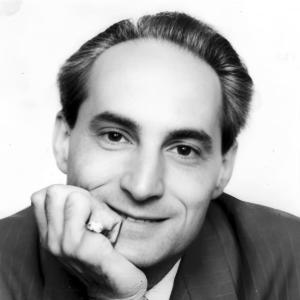LEGENDS OF
LIGHT MUSIC
Roger Roger

Roger Roger was a
leading figure on the French
music scene for many years, and
his fine compositions and
arrangements also won him many
admirers internationally.
He was born on 5
August 1911 at Rouen, Normandy in
France, and to satisfy a personal
whim his father, Edmond Roger,
really did give him the first
name Roger. Music was in the
family: his mother was an opera
singer and his father was a
well-known operatic conductor,
who had been a classmate of
Claude Debussy at the Paris
Conservatoire, so it was hardly
surprising that young Roger
received music tuition at an
early age. His main instrument
was the piano (mainly
self-taught), but harmony and
counterpoint also played an
important role in his education.
His first job on leaving school
was teaching light opera at the
Rouen Arts Theatre
Roger Roger made
his professional conducting debut
at the age of eighteen in a Music
Hall, but it wasn’t long
before radio and films beckoned.
During his long career he claimed
to have been involved in more
than 500 film productions.
Although his
parents encouraged him in
classical music, during his
teenage years young Roger
discovered a love for American
popular songs. Later in his life,
he told Dutch record producer
Gert-Jan Blom that
"…George Gershwin,
Jerome Kern, Cole Porter and
Irving Berlin really were my
teachers, because I learned by
analysing their compositions and
arrangements."
However his
classical upbringing did not
desert him. The composers which
influenced him most were
Stravinsky, Chabrier, Wagner and
Handel, with Ravel providing most
of his inspiration for scoring
and orchestration.
He started writing
for French films towards the end
of the 1930s (firstly
documentaries, then feature
films), and was responsible for
the famous pantomime sequences in
Marcel Carné’s Les Enfants
du Paradis (1944). Several
European radio stations employed
him, especially Radio Luxembourg,
Radio 37 and Europe 1; he was
closely involved with the early
programmes on the new French
Television service.
fter the Second
World War Roger played piano and
conducted a 35-piece orchestra
for a major French weekly radio
series "Paris Star
Time" (Paris a l’heure
des Etoiles), which was sent all
over the world and even broadcast
in the USA. This featured many of
the big names of that period,
such as Edith Piaf, Jean Sablon,
Maurice Chevalier and Charles
Trenet. His own instrumental
cameos that were featured in the
show brought him to the attention
of the London publishers Chappell
& Co., who were rapidly
expanding their Recorded Music
Library of background music at
that time. Roger’s quirky
compositions soon became
available to radio, television
and film companies around the
world, with distinctive titles
like Jack O’Lantern (Feux
Follets), Paris Fashions (Haute
Couture), The Toy Shop Window (La
Vitrine aux Jouets) and The
Toilers (Grands Travaux). Usually
he recorded his own music in
Paris, and the unique studio
sound added to the special charm
that these works possessed. In
addition to his brighter numbers,
he was also required to create
pieces of a more serious nature,
including some heavy, repetitive
tracks that could be used as
accompaniment for industrial
scenes in documentaries. A
composer of mood music has to be
able to write for almost any kind
of subject, and this presented no
problems for Roger.
The Paris office
of Chappells used to issue its
own series of LPs of background
music, and from the mid-1950s
onwards Roger recorded almost 20
albums of his own compositions
for them. He often worked with
his childhood friend, Nino
Nardini. His widow, the opera
singer Eva Rehfuss, remembers
that Chappells’ agent in the
USA was particularly successful
in getting Roger’s music
used in various soap operas.
Considering how
busy Roger was in films and
broadcasting, it is surprising
that he didn’t make more
commercial recordings. He never
had an exclusive contract, so his
occasional releases appeared on
various different labels such as
Vega, Polydor, Festival, US
Decca, Everest and MGM. Perhaps
the reason is that he despised so
much of the music that the record
companies wanted him to arrange.
He held his own orchestra in such
high esteem that he didn’t
want it to be associated with
what he regarded as an inferior
product.
Roger’s own
compositions have, at times, been
compared with the American Leroy
Anderson, although they never
actually met. But a close
collaboration, which developed
into a strong friendship, grew up
between Roger and Frank
Chacksfield. The two worked
together on BBC shows, and in a
series called
"Performance" for
French radio. By a strange
co-incidence, Frank died just
three days before Roger in 1995.
Roger also knew Lalo Schifrin
well, but it was more of a
friendship than a working
relationship, because they each
preferred to compose on their
own.
Roger Roger died
in Paris on 12 June 1995 aged 83.
He managed to create his own
unique sound through his
brilliant compositions and
orchestrations, and one suspects
that future generations of
music-lovers will re-discover and
enjoy his melodious creations for
a long time to come.
David Ades (2003)
|